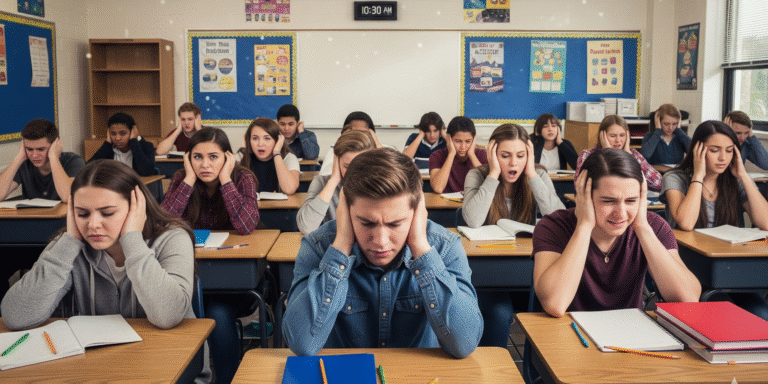Teaching Through the Pandemic 1
I taught through the biggest disruption most of us have ever seen. What finally made sense wasn’t the screen time or the tech—we were just trying to be present with kids who needed something steady. Now I know it wasn’t about keeping up with the chaos—it was about holding on to whatever sense of classroom felt human.
As I think about my schooling in the 60s and 70s, I am amazed at the amount of technology available to teachers and students today. Back in my high school days, using a simple four-function calculator in math class was considered cheating. Back then, incorporating technology into a lesson amounted to a teacher displaying a transparency on an overhead projector.
This year, every student in my classes had a fast, internet-connected computer capable of live two-way interaction with me and multiple options for asynchronous instruction when that was not possible.
The promise of live interaction with students was exciting to me at the beginning of the year. In practice, the ability of students to turn off their cameras and their unwillingness to use their microphones made the experience a lonely and one-sided proposition.

At first, I was determined to require students to have their cameras turned on, but I eventually gave up that cat and mouse fight and simply hoped students were following along to my lesson.
I started the year with the goal of putting my entire class into Microsoft OneNote. In short, I bought into the hype, but then reality set in. I soon realized that there were three ways students can access OneNote, and each way had its own peculiar instructions. This became a huge liability when a few kids in each class could not see my newly shared documents. I would then have to figure out what version of OneNote a student was using and then explain how students could manually sync their notebooks with the server.
Problems like these happened to at least one student a day in many classes and required whole classes to wait while I helped the one student with tech issues. In short, despite its great promise, technology sometimes created more problems than it solved.
Teachers Won’t Be Leaving This Year in the Past
I am afraid our actions this year set some precedents that will be hard to move beyond. It is clear many districts and the state want to continue to offer online learning, but at least at the local level, I don’t see full-time online-only schools as a viable option for most districts. Individual districts are unlikely to see the demand for purely online classes to justify the expense of full-time teachers.
To be successful as ongoing virtual schools, the rigor and expectations of online classes will have to increase. When students learn of these higher expectations, demand is likely to decrease further. Based on my experience, simply requiring students to have their cameras on and to be fully engaged for the whole class will cause some students to reject the option of a virtual school.

Given the financial constraints and lower demand, I expect hybrid classes will once again be the unfortunate solution many districts employ.
This school year was one in which administrators in my district told teachers to demonstrate grace to students. I expect that was true in almost all Texas school districts, and it was very appropriate, especially at the beginning of the year.
As the year progressed I heard from many teachers who saw that grace was taken as a license to complete assignments very late and have multiple opportunities to achieve passing grades. Reorienting students to the pre-pandemic standards is going to take teachers being unwavering in their expectations. With administration support, we can return to higher expectations, but I don’t think it will be quick or without struggles.
Some Admins Got It. Some Never Did.
I have been fortunate to work with a group of administrators who demonstrated that they understand how difficult this year has been for teachers. We did not always see eye to eye with every administrative decision, but they seemed to adjust their expectations as they heard from more teachers as the year wore on.
For the opportunity to work in this environment, I am truly grateful, but over the last year, I heard from teachers in other schools who were not so fortunate. Many teachers told me of administrators who would not modify their expectations during the pandemic and of the stress and anxiety that caused them.
When I was in college, I worked for a time delivering pizzas for Dominoes. Back in the 1990s, the company promised delivery in 30 minutes or less. There were nights when the weather was severe, and some streets would flood. Occasionally I’d have to park a half-block away from the home and wade through ankle-high water to make it to the customer’s door.
Instead of showing gratitude and tipping me for bringing them dinner on a nasty, stormy night, some would complain that the delivery took 40 minutes and then tell me they wanted the guaranteed delivery discount.
Some teachers have told me they have seen that kind of attitude in their administrators, which, in part, fueled our next topic.
We Are Losing Many Good Teachers
Back in my last semester of college, I went to a job fair for a Houston-area district. Upon walking into the room, the district representatives were all upbeat, friendly, and engaging. After a few minutes of good PR, an administrator asked what certification I had. When I told them I had a 6-12 Social Studies Composite, she dismissed my certification as “a dime a dozen.”

More than 25 years later, finding any teachers to fill positions is challenging, and it is much more so when you aspire to hire only the top prospects. Despite this, some schools, perhaps unwittingly, give teachers the impression they are easily replaced as if some colossal surplus of applicants exists.
Attitudes like this are so wrong, not only from a decency perspective but also from an economic one too. Every smart business knows it is easier to keep good employees than to hire and train new ones.
Some of the people who are walking away are retiring much earlier than they planned before Covid-19. Others are fleeing the teaching profession to take jobs in the private sector that do not require working the extra hours typical of teaching
Many of these moves can be traced back to the unyielding expectations and a perceived lack of respect from their administrators.
Sailing Through the Storm
A familiar motivational poster features a photo of a sailboat and the words, “You cannot direct the wind, but you can adjust your sails.” The district expected every teacher to change their sails. Why was it not so with all administrators?

Teaching through the pandemic felt less like sailing and more like bouncing on a trampoline — just when I thought I had my footing, something sent me flying sideways. Wi-Fi failed, cameras “broke,” and sometimes I spoke to a grid of black boxes that may or may not have contained actual kids. But even then, learning happened. Not neatly, not without bruises, but enough to prove that persistence beats polish.
Maybe that’s the point. Schools aren’t meant to be smooth seas anyway. They’re noisy, unpredictable, and occasionally ridiculous — and that’s where the life is. If we can carry forward the grit, the humor, and the stubborn hope that kept us afloat during those years, then maybe we’ll be better prepared for the storms still to come.







